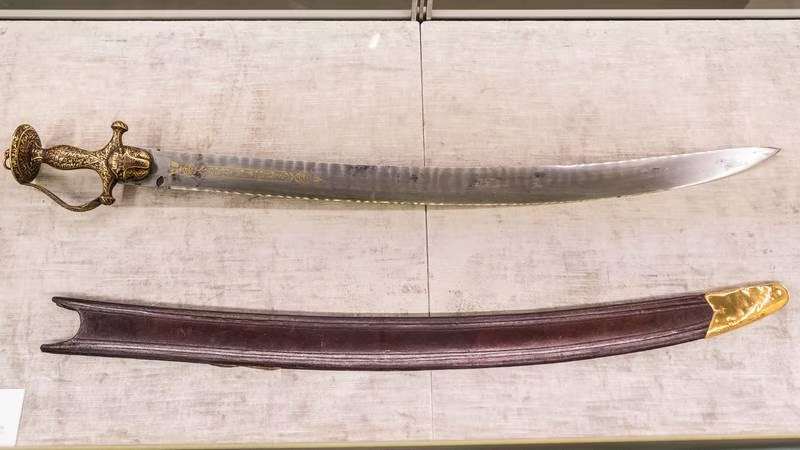Stunning Pieces on Display in DIFC, Dubai
In a splendid showcase of artistry and history, Christie’s auction house in the Dubai International Financial Centre (DIFC) is offering a tantalising glimpse into its upcoming “Art of the Islamic and Indian Worlds” sale. Scheduled for October 27th in London, this auction promises a treasure trove of exquisite ceramics, manuscripts, textiles, metalwork, carpets, and works on paper from diverse corners of the Islamic world. From Iznik pottery to Tipu Sultan’s legendary sword, the displayed pieces span centuries and cultures, providing a captivating journey through history and craftsmanship.
Iznik Pottery: A Gem of Ottoman Turkey
One of the star attractions on display is a 16th-century Iznik pottery dish from Ottoman Turkey, valued at up to $150,000. This intricately crafted piece showcases a delicate pattern thinly painted in a captivating color known as bole red, allowing the white ground to shine through in patches. Iznik, renowned for its hand-painted tiles and ceramics during the Ottoman era, witnessed a significant influence from Chinese porcelain, leading to the birth of this distinctive pottery tradition.
Sara Plumbly, a director at Christie’s, explains the historical context: “Through the 14th and 15th centuries, Chinese porcelain was imported into the Islamic world and treasured as a prized possession. Ottoman sultans responded by establishing production in Iznik in the late 15th century, creating exquisite pieces that continued through the 16th and 17th centuries.”
Tipu Sultan’s Sword: A Symbol of Resistance
Another remarkable artifact on display is a sword and scabbard from the personal armour of Tipu Sultan, the formidable ruler of Mysore, South India, who reigned from 1782 to 1799. This exceptional item, valued at up to $2.5 million, comes from the estate of Charles Cornwallis and has been passed down through generations. Tipu Sultan, known as the “Tiger of Mysore,” proved to be a formidable adversary for the British in India, leading a strong army and embracing Western military technology.
Plumbly sheds light on Tipu Sultan’s symbolism: “Tipu was associated with the symbolism of the tiger, earning him the moniker ‘Tiger of Mysore.’ He integrated the tiger motif into arms, armour, buildings, and even his throne. The sword, with its Bubri stripped pattern, also features verses from different passages of the Quran.”
A Carpet of Exceptional Worth: The Baron Edmond de Rothschild Royal Safavid
From the rich tapestry of rugs and carpets in the auction, one piece truly stands out: The Baron Edmond de Rothschild Royal Safavid. Estimated to be worth $2.5 million to $3.7 million, this carpet boasts a fascinating history. It passed through the hands of both the Rothschild and Getty families at different times and is believed to have been woven in Qazvin, North Persia, in the 16th century.
:quality(70)/cloudfront-eu-central-1.images.arcpublishing.com/thenational/HKFRZ7TB7ZHFNBKKSC7JOEWJAU.jpg)
Distinguished by its burgundy red field adorned with a complex network of scrolling vines, palmettes, blossoms, buds, leaves, and vibrant pheasants, this carpet is a testament to the artistry and craftsmanship of its creators. Made by a group of artisans using wool pile on a silk and cotton foundation, it offers a glimpse into the opulent world of Persian carpets from centuries past.
A Glimpse of Cultural Heritage: The Art of the Islamic and Indian Worlds Exhibition
The “Art of the Islamic and Indian Worlds” exhibition is a celebration of cultural heritage and artistic excellence. It offers visitors in Dubai a limited-time opportunity to marvel at these exquisite pieces, each with its own story to tell. The exhibition runs until Thursday, providing art enthusiasts and collectors with a chance to immerse themselves in the rich tapestry of Islamic and Indian artistry that will soon find new homes around the world.
Feature Imagee: The sword and sheath of the Mysore ruler Tipu Sultan, valued at up to $2.5 million. Courtesy: Antonie Robertson / The National
Tipu Sultan’s Bedchamber Sword Sold for Rs. 143 Crore at an Auction House in London

Contributor





